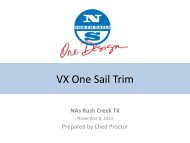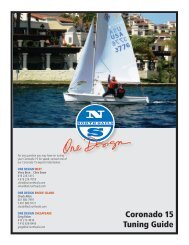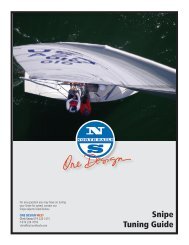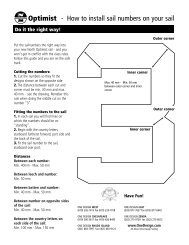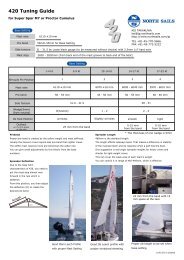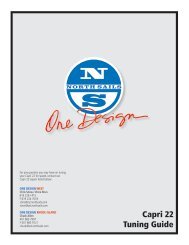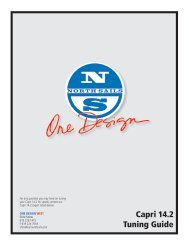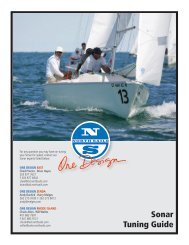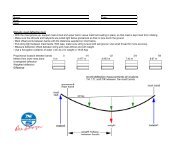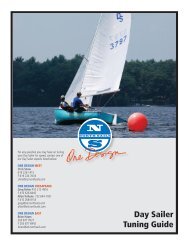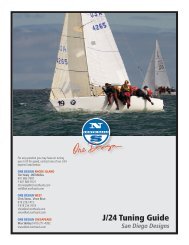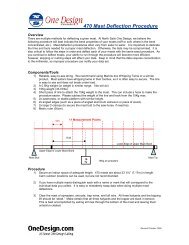Soling Tuning Guide - North Sails - One Design
Soling Tuning Guide - North Sails - One Design
Soling Tuning Guide - North Sails - One Design
Create successful ePaper yourself
Turn your PDF publications into a flip-book with our unique Google optimized e-Paper software.
For any question you may have on tuning<br />
your <strong>Soling</strong> for speed, contact our<br />
<strong>Soling</strong> experts listed below:<br />
ONE DESIGN WEST<br />
Vince Brun<br />
619 226 1415 F 619 224 7018<br />
vince@od.northsails.com<br />
<strong>Soling</strong><br />
<strong>Tuning</strong> <strong>Guide</strong>
NORTH SAILS<br />
<strong>Soling</strong> <strong>Tuning</strong> <strong>Guide</strong><br />
The following tuning guide is meant to be<br />
a good starting point in setting up your<br />
boat. Depending on your crew weight,<br />
strength, sailing style and local conditions,<br />
you may have to alter your rig slightly. As<br />
you read this, write down any questions<br />
you might have, and we will be happy to<br />
discuss them with you in more detail.<br />
We are trying to achieve a rig set up that is<br />
fast in all conditions: upwind, reaching and<br />
running. Your new <strong>North</strong> sails are design<br />
around this “ all purpose “ philosophy.<br />
MAST RAKE AND SHROUD TENSION<br />
Most boats have an adjustable forestay<br />
which allows the crew to change the mast<br />
rake for different wind velocities. Our rake<br />
is checked by measuring the amount of<br />
forestay that exceeds the mast length.<br />
Hold your forestay along the front of the<br />
mast and simply mark the forestay at<br />
the point where the bottom of the mast<br />
would be. We check our rake by measuring<br />
the distance from this mark to where<br />
the forestay intersects with the deck. We<br />
suggest you set the rake at 29” inches.<br />
After the rake is set, It is possible to make<br />
marks on the mainsheet, backstay, and jib<br />
clew heights for different wind and wave<br />
conditions. In light wind conditions (under<br />
7 knots) we suggest a 30” inches rake.<br />
This will increase “ feel “ and make the<br />
boat easier to steer. Remember that every<br />
time you change the rake, all these control<br />
marks have to be changed.<br />
SHROUDS TENSION<br />
Our shroud tension is measured with the<br />
shroud in the forward position, and the<br />
backstay on, so the headstay is snug at<br />
29” inches of mast rake. Uppers should be<br />
at 700 lbs. at all conditions.<br />
Lowers should be set so the mast (when<br />
sailing), have 1 1/2” inches (one and half<br />
inches) of sag at the spreaders, for light<br />
air; increasing tension to 500 lbs. at 18<br />
knots of wind.<br />
NOTES:<br />
- Please remember that the more upper<br />
shroud tension you have, the more prebend<br />
you will have.<br />
- If you have a soft mast, and or the<br />
mainsail looks a bit flat, you may need less<br />
upper tension.<br />
SHROUD POSITION<br />
We have five settings for the fore and aft<br />
movement of the shroud position at the<br />
deck. The total travel is 12” inches.<br />
Track<br />
position<br />
#1<br />
full forward<br />
#2<br />
#3<br />
middle track<br />
Wind<br />
Light air<br />
Light to<br />
Medium<br />
Medium<br />
Wind<br />
range<br />
0-7 Knots<br />
7-10 Knots<br />
10-16 Knots<br />
#4 Fresh 16-20 Knots<br />
#5<br />
full aft<br />
Strong<br />
20+ Knots<br />
Be careful not to de-power the boat too<br />
quickly, especially with waves.<br />
SAIL COMBINATIONS<br />
We recommend the following sail<br />
combinations:<br />
0- 14 knots<br />
ES-12 Main and V-1 plus Jib<br />
8- 20 knots<br />
ES-12 Main and V-1 Turbo Jib<br />
18 knots and above<br />
ES-12 Main and A-1 Jib<br />
BACKSTAY<br />
There are two things that the backstay<br />
does. Controls the fullness in the mainsail<br />
and also the forestay sag. This is probably<br />
the most important adjustment in the<br />
<strong>Soling</strong>. The more backstay tension, the<br />
flatter the main, and the less forestay<br />
sag results in a flatter jib. I have my<br />
backstay marked on every inch, so is easy<br />
to repeat fast settings and have the boat<br />
ready, quickly after mark rounding. Our<br />
mainsail is designed so that the mast<br />
bend and forestay sag are matched for the<br />
conditions.<br />
MAINSHEET TENSION<br />
The mainsheet controls the top part of the<br />
mainsail. The quickest and most accurate<br />
way to trim the mainsail is to watch the<br />
angle of the top batten. Sighting from<br />
under the boom, the top batten should<br />
be parallel to the boom most of the<br />
time, if not in overpowered conditions. In<br />
flat water, the top batten can point five<br />
degrees to weather of the centerline, and<br />
when overpowered, it should open from<br />
centerline until helm balances.<br />
Visit our web site at www.<strong>One</strong><strong>Design</strong>.com for the latest <strong>Soling</strong> news and tuning tips.<br />
© 2007 <strong>North</strong> <strong>Sails</strong> <strong>One</strong> <strong>Design</strong>. All rights reserved.<br />
1
NORTH SAILS<br />
<strong>Soling</strong> <strong>Tuning</strong> <strong>Guide</strong><br />
BOOM VANG<br />
The rule of thumb, is to have the vang<br />
adjusted for the downwind legs, so the top<br />
batten is parallel to the boom.<br />
This control is also important when close<br />
hauled, by helping control the forestay<br />
sag and making the jib either more or<br />
less powerful. In smooth water, the vang<br />
should not be used, so the forestay is as<br />
straight as possible. In choppy waters,<br />
boom vang should be used, and by<br />
experimenting you will be able to find the<br />
perfect tension, which is normally when<br />
helm is almost neutral.<br />
MAINSAIL TRAVELER<br />
The boom should be about 4 to 5 inches<br />
above centerline until both crews are<br />
over the side and boat is overpowered.<br />
At this point traveler should be placed on<br />
the centerline (not very often the traveler<br />
should be placed below centerline).<br />
JIB TRAVELER<br />
A good starting position is 10 to 11 inches<br />
athwart ship centerline. In heavy air, it<br />
should go outboard 2 to 4 inches (20<br />
knots and above), this will help stop the<br />
back wind on the mainsail under heavy<br />
breezes.<br />
CLEWBOARD POSITION<br />
This will vary from boat to boat, but the<br />
third hole for the V-1 jib and the A-1 jib<br />
will be a good starting point. When it is<br />
light and crew is inside or not fully hiked,<br />
make the jib fuller down low, by going to a<br />
higher hole (or just by moving the whole<br />
jib up). When crew is fully hiked and the<br />
wind is stronger, make the foot flatter,<br />
by moving to a lower clew hole (or by<br />
moving the whole jib down). For full power<br />
conditions, the jib should luff evenly from<br />
top to bottom.<br />
LUFF TENSION<br />
All jibs should be set with minimum luff<br />
tension, just enough to take most of<br />
scallops out; DON’T OVER STRETCH. Too<br />
much tension moves the draft forward,<br />
which is very slow.<br />
OUTHAUL<br />
In light air the outhaul should be<br />
stretched to about 1 to 1 1/2” inches<br />
from maximum out. As the wind increases,<br />
pull the outhaul all the way out so the<br />
sail is perfectly flat right of the boom. In<br />
reaching, the outhaul should at maximum<br />
ease (about 3” inches).<br />
RUNNING AND REACHING WITH<br />
SPINNAKER<br />
A lot can be done in terms of speed when<br />
running and reaching, and if you are faster<br />
than the competition, that could be the<br />
necessary edge you need to win.<br />
Is a well know fact that, when sailing<br />
downwind, the fastest setting is by moving<br />
the mast as far forward as your backstay<br />
would allow.<br />
The other important controls are the pole<br />
fore & aft and up & down. For fore & aft<br />
adjustments try to have the luff of the<br />
spinnaker perpendicular right out of the<br />
pole.<br />
For up & down control, the pole should be<br />
adjusted so the clews are even height from<br />
the water.<br />
Sail Care<br />
Always store your sails away from the sun<br />
and make sure they are clean and dry.<br />
Be sure that you always “roll “ your<br />
upwind sails, this will help them last<br />
longer and stay wrinkle free.<br />
If you have any questions or comments<br />
about our <strong>Soling</strong> <strong>Tuning</strong> <strong>Guide</strong>, don’t<br />
hesitate to call us anytime.<br />
Contact <strong>North</strong> <strong>Sails</strong><br />
For tuning information and complete<br />
details on how to setup your <strong>Soling</strong> sails<br />
contact the <strong>North</strong> <strong>Soling</strong> experts listed on<br />
the cover of this guide.<br />
Good Sailing!<br />
Visit our web site at www.<strong>One</strong><strong>Design</strong>.com for the latest <strong>Soling</strong> news and tuning tips.<br />
© 2007 <strong>North</strong> <strong>Sails</strong> <strong>One</strong> <strong>Design</strong>. All rights reserved.<br />
2
NORTH SAILS<br />
<strong>Soling</strong> <strong>Tuning</strong> <strong>Guide</strong><br />
NORTH SAILS ONE DESIGN<br />
QUALITY CONTROL CHECK<br />
<strong>Soling</strong><br />
MAINSAIL JIB SPINNAKER<br />
Corners Corners Corners<br />
Cunningham Battens Numbers (one side only)<br />
Measurement stamp Luff Hanks Country Code (one side only)<br />
Leech Cord Measurement stamp Measurement stamp<br />
Royalty Telltales Royalty<br />
Numbers Leech telltales <strong>North</strong> Logo<br />
Country Code Leech Line Bag<br />
Battens<br />
Leech Telltales<br />
Insignia<br />
<strong>North</strong> Logo<br />
Trim chord<br />
Royalty<br />
<strong>North</strong> Logo<br />
Bag<br />
Bag<br />
Checked by: ______________________<br />
Date: ____ / ____ / ____<br />
Figure 4 - Mast "neutral" position, note marks<br />
in front of and behind neutral mark.<br />
Visit our web site at www.<strong>One</strong><strong>Design</strong>.com for the latest <strong>Soling</strong> news and tuning tips.<br />
© 2007 <strong>North</strong> <strong>Sails</strong> <strong>One</strong> <strong>Design</strong>. All rights reserved.<br />
3



